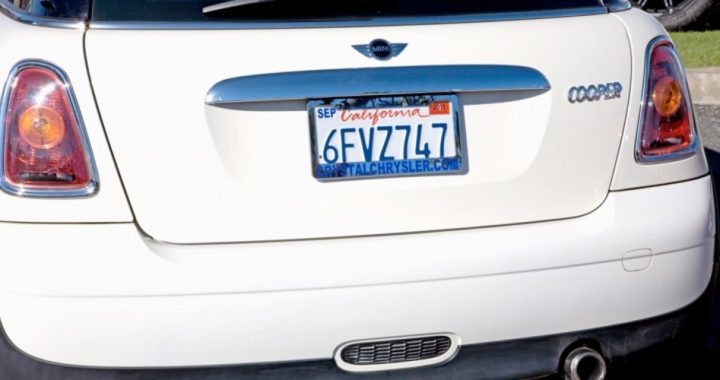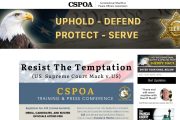
Every day, the power of the police (and their federal financiers) to track the movements of every American expands. The latest loss of liberty involves the ability of license plate tracking software to recognize the faces of individual travelers in target vehicles.
In an exclusive, The Verge reported on January 26, “The Immigration and Customs Enforcement (ICE) agency has officially gained agency-wide access to a nationwide license plate recognition database, according to a contract finalized earlier this month. The system gives the agency access to billions of license plate records and new powers of real-time location tracking.”
According to the General Services Administration website, ICE has awarded a contract “to obtain query based access to a commercially available License Plate Reader (LPR) database.”
While the recipient of the contract is not identified on the website, the story published by The Verge indicates that Vigilant Solutions will be providing the license plate readers to ICE.
“Like most other law enforcement agencies, ICE uses information obtained from license plate readers as one tool in support of its investigations,” spokesperson Dani Bennett said in a statement, as quoted in The Verge’s report.
Vigilant Solutions, an LPR manufacturer that’s been the recipient of numerous government contracts, boasts of being a “trusted provider to tens of thousands of law enforcement professionals.”
The Vigilant Solutions database reportedly “contains 2 billion entries,” with “70 million additional license plate photographs being added each month.”
Lest anyone doubt the scope and power of these tracking technologies, consider the following description of one of Vigilant’s latest products, the Mobile Companion:
Vigilant Solutions’ Mobile Companion is an industry-exclusive mobile app delivering the benefits of Vigilant’s Intelligence-Led Policing Package (including license plate recognition (LPR) and facial recognition technologies) to your mobile device.
The Mobile Companion is available to every officer with a mobile device and proper user permissions, as set by an Agency Manager. With the Mobile Companion, officers are now able to scan license plates, match against agency hotlists, query historical data, use the exclusive Mobile Hit Hunter feature to locate nearby hits generated by the Vigilant LPR network, and verify identities in the field using facial recognition.
Simplicity is the selling point of this technology, according to information provided by Vigilant on its website. “Plate capture is simple,” they boast. “Mobile Companion’s interface is incredibly intuitive,” they claim.
And, “Facial Recognition is made incredibly simple and convenient on the Mobile Companion. Simply take a picture, or upload an image from a file or from social media, and match against the available gallery. Vigilant prepopulates the gallery with mugshot data, CrimeStopper data, and registered sex offender data. Agency Managers may upload additional images into their gallery (using the web interface) for better matching against local known individuals.”
Don’t drive anywhere that suspected criminals frequent, because Vigilant’s Mobile Companion app empowers police to “query for possible associates of known criminals with just a few clicks of the mouse based on license plates frequently seen in close proximity to the subject.”
The Vigilant-developed facial recognition software supporting the expanded capabilities of the license-plate trackers is known as FaceSearch. In order to lure new law-enforcement customers, the power of the product is proudly proclaimed:
FaceSearch is an easy-to-use facial recognition solution that works. Available via the web, on mobile devices, and as a PC-based application, FaceSearch was developed by Vigilant to deliver a functional, scalable and affordable solution like no other. Hosted in the cloud, FaceSearch offers easy importing and integration capabilities, along with pre-populated face image data from Vigilant.
Over 350 facial vectoring algorithms are at the heart of Vigilant Solutions’ FaceSearch. Rather than making use of commercially available facial recognition engines, Vigilant leveraged its experience in image recognition to develop these new facial vectoring algorithms in-house. Why? — to benefit you in terms of accuracy, speed, and flexibility in deployment.
Then, lest any potential police department believe that this tool would be just too hard to use, Vigilant provides the following testimonial from a satisfied customer: “FaceSearch is the simplest interface I have seen for a facial recognition product. It has just the right amount of functionality without getting too technical or difficult.”
If the report published by The Verge is accurate, ICE agents will make use of the full panoply of plate-recognition technology.
The Verge asserts: “ICE agents would be able to query that database in two ways. A historical search would turn up every place a given license plate has been spotted in the last five years, a detailed record of the target’s movements. That data could be used to find a given subject’s residence or even identify associates if a given car is regularly spotted in a specific parking lot.”
A clue to the purpose for which ICE will deploy its new tool is revealed in an analysis of the technology published by the Department of Homeland Security.
In the report entitled “Acquisition and Use of License Plate Reader Data from a Commercial Service,” published in 2015, DHS states:
ICE has identified a number of benefits from the use of commercial LPR data in its mission activities. Knowing the previous location(s) of a vehicle can help determine the whereabouts of subjects of criminal investigations or priority aliens to facilitate their interdiction and removal. In some cases, when other leads have gone cold, the availability of commercial LPR data may be the only viable way to find a subject. This LPR data can also show the previous movements of a subject, which may help ICE law enforcement personnel plan to apprehend a subject in a safe manner that is not near sensitive locations, such as schools. This enhances the safety of the public as well as the officers involved in questioning or detaining an individual. Commercial LPR data also allows ICE to identify connections between a car and an address known for criminal activity, which may help identify individuals involved in that activity and lead to the successful conclusion of an investigation.
The expansion of the surveillance state — as chronicled for years by The New American — is creating a country where there isn’t an unmonitored place in the real or cyber world. From Trapwire to Prism, from XKeyscore to the monitoring of snail mail, the federal government and the law enforcement that is regularly the beneficiary of its legal plunder of citizens are always watching us.
One picture of a car and its passengers, one unwarranted wiretap, one unwarranted seizure of a phone record, one search of records of an individual’s digital communications is too many. If we are a republic of laws, then the supreme constitutional law of the land must be obeyed.
The standard is not whether federal agents or politicians insist that the privations are necessary. The standard is the Constitution — for every issue, on every occasion, with no exceptions. Anything less than that is a step toward tyranny. As James Madison wrote, “It is a universal truth that the loss of liberty at home is to be charged to the provisions against danger, real or pretended, from abroad.”
Photo: Solidago/iStock Unreleased



